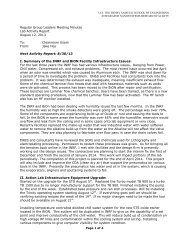Download Lab Safety Manual - Integrated Nanosystems Research ...
Download Lab Safety Manual - Integrated Nanosystems Research ...
Download Lab Safety Manual - Integrated Nanosystems Research ...
You also want an ePaper? Increase the reach of your titles
YUMPU automatically turns print PDFs into web optimized ePapers that Google loves.
6.1 Solvents…………………………………………………….…………………………………….. 16<br />
• Flammable Solvents…………………………………………………………………… ……16<br />
• Chlorinated Solvents……………………………………………………………………… 17<br />
• Glycol Ether Solvents………………………………………………………………………. 17<br />
6.2 Oxidizers………………………………………………………………………………………... 17<br />
• Peroxides……………………………………………………………………………………. 17<br />
• Sulfuric acid and “Piranha” clean…………………………………………………………... 17<br />
• Other Oxidizing Acids…………………………………………………………………….... 18<br />
6.3 Hydrofluoric Acid and Fluoride Containing Chemicals………………………………………... 18<br />
6.4 Alkali/Bases…………………………………………………………………………………….. 18<br />
• KOH and TMAH Etchants…………………………………………………………………. 18<br />
• TMAH………………………………………………………………………………………. 18<br />
• Removers and strippers (SVC 127, PRS 1000, and related Chemicals)……………………. 19<br />
6.5 Gallium Arsenide……………………………………………………………………………...... 19<br />
• Solid GaAs waste…………………………………………………………………………… 19<br />
7. Hazardous Gases…………………………………………………………………………… 19<br />
7.1 Storage………………………………………………………………………………………...… 19<br />
7.2 Handling and Usage…………………………………………………………………………...… 19<br />
7.3 Toxic Gas Detection System…………………………………………………………………….. 19<br />
8. Specific Hazardous Gases……………………………………………………………….... 20<br />
8.1 Pyrophoric (flammable) Gases………………………………………………………………….. 20<br />
• Silane (SiH4)……………………………………………………………………………...… 20<br />
• Dichlorosilane (SiH2Cl2)…………………………………………………………………… 20<br />
8.2 Corrosive Gases………………………………………………………………………………….. 20<br />
• Hydrochloric acid (HCl)…………………………………………………………………… . 20<br />
• Ammonia (NH3)…………………………………………………………………………….. 20<br />
• Chorine (Cl2)………………………………………………………………………………... 20<br />
• Boron Trichloride (BCl3)…………………………………………………………………… 20<br />
8.3 Highly Toxic Gases……………………………………………………………………………... 20<br />
• Nitrogen Dioxide (NO2)………………………………………………………………….… 20<br />
• Xenon Difluoride (XeF2)…………………………………………………………………… 20<br />
• Fluorine (5% / 95% He)…………………………………………………………………….. 20<br />
8.4 Non-toxic Gases……………………………………………………………………………….... 20<br />
• Nitrogen (N2) or Liquid Nitrogen (LN2)…………………………………………………… 21<br />
• Etch Gases………………………………………………………………………….……….. 21<br />
9. How to Respond in Emergencies……………………………………………………… 21<br />
9.1 INRF/BiON Building Emergency Response Procedures………………………………………. 21<br />
9.2 Building and <strong>Lab</strong> Evacuations………………………………………………………………….. 22<br />
• Building Evacuation……………………………………………………………………...…… 22<br />
• Response Procedures……………………………………………………………………….…. 22<br />
• <strong>Lab</strong>oratory Evacuation………………………………………………………………………... 22<br />
* Response Procedures…………………………………………………………………….….. 22<br />
* Response Procedures……………………………………………………………………...… 22<br />
9.3 Major Earthquake………………………………………………………………………………. 23<br />
* Response Procedures…………………………………………………………………...…… 23<br />
9.4 Life-threatening Medical Emergency………………………………………………………….. 23<br />
* Response Procedures……………………………………………………………………….. 23<br />
9.5 Non-health Threatening Emergency………………………………………………………….… 23<br />
* Response Procedures:………………………………………………………….……….….. 23<br />
9.6 Electrical power Outage:…………………………………………………………………..…… 23<br />
* Response Procedures:……………………………………………………………………… 23<br />
9.7 Chemical Spills:………………………………………………………………………………… 23<br />
* Response Procedures:……………………………………………………………………… 24<br />
* Response Procedures:…………………………………………………………………....… 24<br />
3



